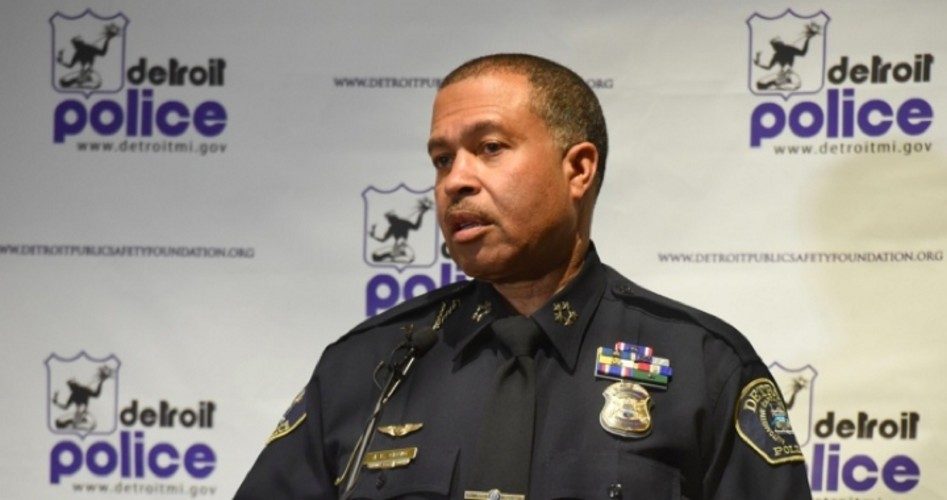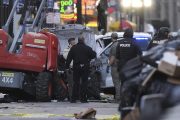
Following the Paris attacks, Detroit police chief James Craig (shown) reiterated his policy of encouraging his citizens to continue to arm themselves:
A lot of Detroiters have CPLs (concealed pistol licenses), and the same rules apply to terrorists as they do to some gun-toting thug: if you’re a terrorist, or a carjacker, you want unarmed citizens.
Since his arrival in Detroit in 2012, Craig has seen his citizens heed his call and has simultaneously seen violent crime fall significantly. Seven thousand of them received their CPLs the year after Craig took over, and another 7,500 were added to the rolls a year later. At present nearly one in every 20 Detroiters is carrying concealed.
Added Craig:
If you look at what happened in Paris, I’m not saying if more citizens had had guns it would have stopped the terrorists. But it sure might have helped.
If you’re sitting in a restaurant, and you aren’t allowed to have a gun, what are you supposed to do if someone comes in there shooting at you? Throw a fork at them?
Oakland University criminal justice professor Daniel Kennedy agreed with Craig:
We don’t have laboratories where we can test these theories, but there is something to the argument that terrorists want a high body count. And if they can only shoot a few people before they’re taken out themselves, it wouldn’t have the kind of impact they want.
On 60 Minutes last week, Washington, D.C.’s police chief Cathy Lanier urged her citizens who carry to “take the gunman out” if they are threatened:
If you’re in a position to try and take the gunman down, to take the gunman out, it’s the best option for saving lives before the police can get there.
Former New York City police detective and popular media personality Bo Dietl was much more direct: “On my hip I’ve got a 9 mm Glock, so I’m prepared if something happens. If everyone was prepared … maybe we’d have fewer casualties. Domestic terrorists hit places where they don’t think they’ll get much resistance, like movie theaters. Whoever is able to carry a gun legally, it would help.”
Larry Keene, general counsel for the National Shooting Sports Foundation, commented on the recent study from the Crime Prevention Research Center showing that as the number of those carrying concealed guns increases, violent crime and murder rates decrease:
It puts the lie to the myth promulgated by anti-gun individuals that somehow more law-abiding citizens carrying guns will lead to more crime.
In fact, quite the opposite is the case: more law-abiding citizens own firearms for self-protection, and crime continues to decline.
Keene called efforts to restrict the rights of law-abiding citizens in order to reduce crimes committed by criminals a “failed experiment”:
The public increasingly understands that gun control is a failed social experiment … that it doesn’t work.
All gun control ever does is infringe on the rights of the law-abiding citizens and does nothing to stop criminals from illegally acquiring firearms, and it doesn’t stop them from misusing them in crime.
Eugene O’Donnell, a former officer with the New York City police department and currently a professor at the John Jay College of Criminal Justice, also encouraged civilians to take responsibility for their own safety:
I think, after Paris … we need to recognize that there’s definitely a … number of documented mass-casualty shootings that have been ended by off-duty law enforcement and civilians … a large number of these events are going to be over before the cops get there.
Many examples could be cited of “documented mass-casualty shootings” that have been terminated by armed citizens taking responsibility. A dozen examples were assembed by Hunter Roosevelt in his excellent Controversial Times article “12 Mass Shootings Were Stopped by Good Guys With Guns.” Paraphrased below, they include:
• Pearl High School In Pearl, Mississippi when on October 1, 1997 the attack by a student on his fellow students was ended when the assistant principal confronted him with his own .45 caliber handgun and held him until the police arrived.
• Parker Middle School in Edinboro, Pennsylvania when on April 24, 1998 an attack at a school dance by a student was ended when the owner of the dance hall challenged him with a shotgun, holding him at gunpoint until the police arrived.
• Appalachian School of Law (ASL) in Grundy, Virginia, when on January 16, 2002 a former law student started killing professors until he was confronted by students carrying their own sidearms. In this case, ASL was a gun-free zone, which caused a delay while the students retrieved their personal weapons from storage.
• New Life Church in Colorado Springs, Colorado, when on November 9, 2007 Jeanne Assam ended an attempted massacre by a gunman who had carefully planned to massacre hundreds of worshippers.
• New York Mills, N.Y. AT&T store when on May 27, 2010 a man entered the store, carrying a .357 magnum revolver along with a list of the employees he intended to shoot. He was thwarted when a customer, carrying concealed, killed the gunman before he could inflict any damage.
• Sullivan Central High School in Blountville, Tennessee, when on August 30, 2010 a school resource officer confronted a gunman armed with two handguns. For 10 long minutes there was a face-to-face standoff that gave local police time to arrive and neutralize the situation.
• Freewill Baptist Church in Boiling Springs, South Carolina, when on March 25, 2012 a deranged parishioner brought his shotgun into a church service and pointed it at the senior pastor. A worshipper, carrying concealed, confronted the gunman while others tackled him and removed the shotgun from his hands, ending the threat.
• Clackamas Town Center in Clackamas County, Oregon, when on December 11, 2012 a rifle-toting gunman opened fire in a busy food court, killing two and wounding a third. A shopper, carrying concealed, drew his weapon on the gunman who immediately fled the area and ended his life in a nearby stairwell.
• Mystic Strip Club when, on January 11, 2014, a regular customer was turned away from the club due to belligerent behavior. He returned wearing a Halloween mask and carrying a handgun. A bouncer, carrying concealed and seeing the threat, drew his firearm and shot and killed the gunman. Following the incident, the bouncer posted this to his Facebook page: “I did what I felt was right to stop the shooter…. I carry every day, and will continue to do so with the hope that I will never have to pull it out again.”
• An Austin, Texas construction site when, on April 30, 2014, an irate former employee opened fire on his co-workers. The site’s foreman, carrying concealed, traded shots with the former employee. Both were wounded in the confrontation, but the attack was successfully terminated.
• Cache Valley Hospital in Logan, Utah, when on May 15, 2014 a man entered the hospital armed with two handguns. He started making demands and, when they were refused, he announced, “Someone is going to die today!” An armed security guard and two corrections officers engaged the gunman who was shot three times, ending the threat before anyone was injured or killed.
• The Curtis Culwell Center in Garland, Texas, on May 4, 2015, when two ISIS terrorists, offended by an exhibit featuring cartoon images of their beloved Muhammad, opened fire, shooting a security guard before he could return fire. The potential massacre ended when a police officer arrived on the scene shot and killed them both.
When Larry Pratt, executive director of Gun Owners of America, reviewed the study from the Crime Prevention Research Center showing that the more people carry, the lower crime statistics fall, he said:
It ought to give liberals and anti-Second Amendment folks a lot of reason to cry … this is going to be a very worrisome finding for [them].
As more and more Americans come to realize the futility of passing laws that only infringe precious rights without impacting criminal behavior — that what Chief Daniel Craig is recommending for Detroiters applies to themselves as well — they are preparing themselves personally against such attacks by purchasing firearms in ever increasing numbers, and training themselves in responsible behavior in the event they are ever in the middle of such an attack.
Photo of Detroit Police Chief James Craig
A graduate of an Ivy League school and a former investment advisor, Bob is a regular contributor to The New American magazine and blogs frequently at www.LightFromTheRight.com, primarily on economics and politics. He can be reached at [email protected].



